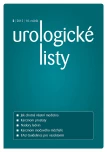Treatment of muscle non-invasive tumours: transurethral resection, novel approaches
Authors:
G. Varga
Authors‘ workplace:
Urologická klinika FN Brno LF MU Brno
Published in:
Urol List 2012; 10(2): 46-49
Overview
Approximately 75–85% of bladder cancer patients present with disease confined to mucosa, which is also labeled as a non-invasive or superficial cancer, more precisely as muscle non-invasive cancer. The curve indicating mortality on bladder cancer in Czech Republic has been increasing pretty slowly during the last two decades, which indicates improvement of diagnostic procedures and detection of the cancer in its early stage. Transurethral resection of bladder cancer (TURB) plays a key role in the management of patients suffering from muscle non-invasive bladder cancer. This method also influences the further development. Use of modern technologies enabling better visualization of occult tumor changes during cystoscopy and TURB is the path to follow to further improve oncologic results and prognosis [1,2].
Key words:
superficial urothelial bladder cancer, transurethral tumor resection, optical coherence tomography, narrow-band imaging, fluorescence cystoscopy, Raman spectroscopy
Sources
1. http://www.svod.cz/analysez
2. Babjuk M. Transurethral Resection of Non–muscle-invasive Bladder Cancer. Eur Urol Suppl 2009; 8:542–548.
3. Babjuk M, Oosterlinck W, Sylvester R et al. EAU guidelines on non-muscle-invasive urothelial carcinoma of the bladder. Eur Urol 2008; 54(2): 303–314.
4. Nieder AM, Brausi M, Lamm D et al. Management of stage T1 tumours of the bladder: international consensus panel. Urology 2005; 66 (Suppl 1): 108–125.
5. Herr HW. High-risk superficial bladder cancer: transurethral resection alone in selected patients with T1 tumour. Semin Urol Oncol 1997; 15(3):142–146.
6. Varga G. Možnosti a místo chirurgické léčby superficiálního karcinomu močového měchýře. Urol List 2011; 9(3): 16–21.
7. Brausi M, Collette L, Kurth K et al. EORTC Genito-Urinary Tract Cancer Collaborative Group. Variability in the recurrence rate at first follow-up cystoscopy after TUR in stage Ta T1 transitional cell carcinoma of the bladder: a combined analysis of seven EORTC studies. Eur Urol 2002; 41(5): 523–531.
8. Brausi MA, Gavioli M, Peracchia G et al. Dedicated teaching programs can improve the quality of TUR of non-muscle-invasive bladder tumors (NMIBT): experience of a single institution. Eur Urol Suppl 2008; 7: 180.
9. Soloway MS, Murphy W, Rao MK et al. Serial multiplesite biopsies in patients with bladder cancer. J Urol 1978; 120(1): 57–65.
10. Schwaibold HE, Sivalingam S, May F et al. The value of a second transurethral resection for T1 bladder cancer. BJU Int 2006; 97(6): 1199–1201.
11. Brauers A, Buettner R, Jakse G. Second resection and prognosis of primary high risk superficial bladder cancer: is cystectomy often too early? J Urol 2001; 165(3): 808–810.
12. Goh AC, Lerner SP. Application of new technology in bladder cancer diagnosis and treatment. World J Urol 2009; 27(3): 301–307.
13. Batlle AM. Porphyrins, porphyrias, cancer and photodynamic therapy – a model for carcinogenesis. J Photochem Photobiol B 1993; 20(1): 5–22.
14. Hungerhuber E, Stepp H, Kriegmair M et al. Seven years’ experience with 5-aminolevulinic acid in detection of transitional cell carcinoma of the bladder. Urology 2007; 69(2): 260–264.
15. Steinbach P, Weingandt H, Baumgartner R et al. Cellular Xuorescence of the endogenous photosensitizer protoporphyrin IX following exposure to 5-aminolevulinic acid. Photochem Photobiol 1995; 62(5): 887–895.
16. Grossman HB, Gomella L, Fradet Y et al. A phase III, multicenter comparison of hexaminolevulinate fluorescence cystoscopy and white light cystoscopy for the detection of superficial papillary lesions in patients with bladder cancer. J Urol 2007; 178(1): 62–67.
17. Zaak D, Karl A, Knuchel R et al. Diagnosis of urothelial carcinoma of the bladder using fluorescence endoscopy. BJU Int 2005; 96(2): 217–222.
18. D’Hallewin MA, Kamuhabwa AR, Roskams T et al. Hypericin-based fluorescence diagnosis of bladder carcinoma. BJU Int 2002; 89(7): 760–763.
19. Pan Y, Xie H, Fedder GK. Endoscopic optical coherence tomography based on a microelectromechanical mirror. Opt Lett 2001; 26(24): 1966–1968.
20. Fujimoto JG, Pitris C, Boppart SA et al. Optical coherence tomography: an emerging technology for biomedical imaging and optical biopsy. Neoplasia 2000; 2(1–2): 9–25.
21. Zagaynova EV, Shirmanova MV, Kirillin MY et al. Contrasting properties of gold nanoparticles for optical coherence tomography: phantom, in vivo studies and Monte Carlo simulation. Phys Med Biol 2008; 53(18): 4995–5009.
22. Manyak MJ, Gladkova ND, Makari JH et al. Evaluation of superficial bladder transitional-cell carcinoma by optical coherence tomography. J Endourol 2005; 19(5): 570–574.
23. Goh AC, Tresser NJ, Shen SS et al. Optical koherence tomography as an adjunct to white light cystoscopy for intravesical real-time imaging and staging of bladder cancer. Urology 2008; 72(1): 133–137.
24. Gono K, Obi T, Yamaguchi M et al. Appearance of enhanced tissue features in narrow-band endoscopic imaging. J Biomed Opt 2004; 9(3): 568–577.
25. Machida H, Sano Y, Hamamoto Y et al. Narrow-band imaging in the diagnosis of colorectal mucosal lesions: a pilot study. Endoscopy 2004; 36(12): 1094–1098.
26. Tsili A, Tsampoulas C, Chatziparaskevas N et al. Computed tomographic virtual cystoscopy for the detection of urinary bladder neoplasms. Eur Urol 2004; 46(5): 579–585.
27. De Jong BW, Bakker Schut TC, Wolffenbuttel KP et al. Identification of bladder wall layers by Raman spectroscopy. J Urol 2002; 168 (4 Pt 2): 1771–1778.
Labels
Paediatric urologist UrologyArticle was published in
Urological Journal

2012 Issue 2
Most read in this issue
- Antimuscarinics and drug interaction
- Imaging methods, their benefits to determine the extent of bladder cancer
- Chemotherapy and radiotherapy of bladder cancer
- Upper urinary tract tumours etiology and diagnostics
